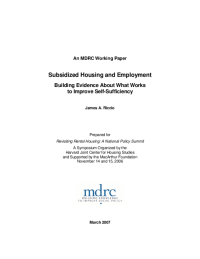Subsidized Housing and Employment
Building Evidence About What Works to Improve Self-Sufficiency
For many years, policymakers have agreed that low-income, working-age people who receive government rent subsidies ought to strive for self-sufficiency and that the housing subsidy system should play an actively supportive role — or at least not stand in the way. This intent is clear in the most recent major public housing reform legislation, the Quality Housing and Work Responsibility Act (QHWRA) of 1998, which makes promoting residents’ self-sufficiency a core objective. A variety of self-sufficiency innovations and housing policy reforms have been tried over the past two decades, and new ones are being proposed all the time. Yet what is striking about innovation in this field is that so little of it is based on credible evidence of “what works.”
This paper, which was prepared for “Revisiting Rental Housing: A National Policy Summit,” a November 2006 symposium organized by the Harvard Joint Center for Housing Studies and supported by the MacArthur Foundation, argues for building a stronger base of evidence in the housing-employment policy arena through an expanded use of randomized controlled trials. Greater use of this methodology, which involves comparing outcomes of program and control groups to which eligible people have been assigned through a lottery-like process, is technically feasible and practical, and it could substantially improve the body of evidence on “what works.” With better knowledge in hand, policymakers and others who wish to improve self-sufficiency outcomes could rely less on hunches and hope in deciding how to achieve those aims. Indeed, many experts see more credible evidence as an urgent policy need.






